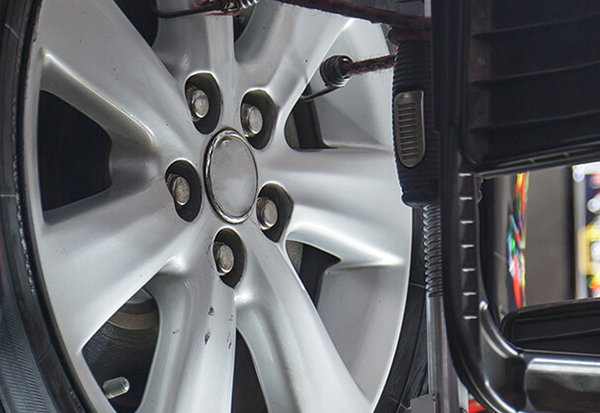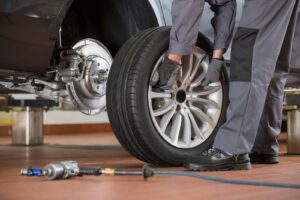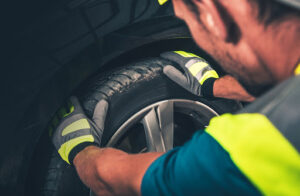Tulsa Tire Shop Guide: The Importance of Tire Balancing and Rotation

The foundation for an efficient and safe vehicle lies in proper tire maintenance. Tires are the only point of contact between your car and the road, making their upkeep critical for optimal performance and safety.
Tire balancing and tire rotation are two important parts of tire maintenance that prevent uneven wear and promote a smooth ride. These two practices work together to extend your tire’s life span and improve fuel efficiency.
At a tire shop, professionals are crucial in educating and assisting vehicle owners in maintaining their tires. By understanding the significance of tire balancing and rotation, you can take proactive steps to ensure your vehicle operates at its best.
In this article, we take a deep dive into the importance of these services and their benefits for your vehicle's performance and your safety on the road.
Understanding Tire Balancing and Rotation
When it comes to maintaining your vehicle's optimal performance and safety, tire balancing and rotation are essential to ensuring a smooth and hassle-free driving experience. It is important to understand the significance of tire balancing and rotation and why these practices are essential for the longevity of your tires and overall driving comfort.
The Importance of Tire Balancing Explained
Tire balancing is a vital maintenance task that evenly distributes the tire and wheel assembly’s weight around the axle. This balance is vital in maintaining stability, enhancing handling, and reducing vibrations while driving. An unbalanced tire can lead to uneven wear, affecting steering control and compromising driving comfort.
These issues not only impact your driving experience but can also pose safety risks on the road. By ensuring your tires are properly balanced, you can enjoy a smoother ride, enhanced maneuverability, and better control over your vehicle.
The Advantages of Routine Tire Rotation
Tire rotation involves moving tires from one position to another on your vehicle at regular intervals. This practice offers a variety of benefits, including promoting even tread wear, improving traction, and extending your tires’ life span. By rotating your tires, you can address disparities in wear patterns between front and rear tires, ensuring balanced performance across all wheels.
Due to factors like steering and braking, your vehicle’s front tires typically wear out faster than the rear tires. Without rotation, this uneven wear can lead to decreased traction, compromised handling, and premature tire replacement. By making tire rotation part of your maintenance routine, you can optimize tire longevity, enhance safety, and save on replacement costs.
Tire rotation and tire rotation are not mere maintenance tasks but investments in your vehicle's performance, safety, and longevity. By prioritizing these practices, you can drive confidently, extend your tires’ service life, and ensure a comfortable and stable ride.
Remember, a well-maintained set of tires benefits your driving experience and contributes to your vehicle’s overall health.

Signs That You May Need A Tire Rotation or Balancing
Have you ever noticed your car vibrating or experienced difficulty maintaining control while steering? These could be early signs of tire issues that need attention. Here are some common warning signs that you may need balancing and/or rotation services.
Vibrations and Steering Issues
When you feel vibrations through the steering wheel or the car itself while driving, it can be unsettling and even alarming. These vibrations are often a sign of imbalanced tires. Tire balancing issues can arise due to unequal tire weight distribution, leading to an uneven ride experience.
Not only does this affect your comfort while driving, but it can also affect your vehicle's performance and safety on the road. By addressing these vibrations promptly and getting your tires balanced at a reputable tire shop, you can ensure a smoother and safer driving experience.
Uneven Tread Wear Patterns
Another indicator that it's time for tire balancing and rotation is uneven tread wear patterns on your tires. If you notice cupping or feathering, where certain areas of the tire treads wear down more rapidly than others, it's a clear indication that your tires are not wearing uniformly.
Uneven tread wear can result from various factors, including improper tire inflation, misaligned wheels, or lack of regular rotation. By addressing these issues promptly, you can extend the life span of your tires, enhance fuel efficiency, and improve overall vehicle performance.
Keeping an eye out for these signs and promptly visiting a trusted tire shop in Tulsa for balancing and rotation services can help you maintain optimal tire health and ensure a safe and smooth driving experience. Remember, proactive maintenance is key to maximizing the longevity and performance of your tires.
The Process of Tire Balancing and Rotation
Tire balancing and rotation are important maintenance services that every car owner should be familiar with to ensure optimal tire performance and longevity. Let's break down the processes involved in tire balancing and rotation to understand their significance.
The Tire Balancing Process
Tire balancing is a precise process that involves equalizing the weight distribution of a tire and wheel assembly to ensure smooth operation and prevent premature wear. The process typically begins with removing the wheels from the vehicle. Once removed, the tire technician will use a specialized machine to determine how much weight is required to balance each tire properly.
Next, the technician will apply lead balancing weights to the inner or outer part of the wheel rim based on the machine's readings. These weights counterbalance any heavy spots on the tire, ensuring uniform weight distribution. Precision is key in this process, as even a slight imbalance can lead to vibrations, uneven tire wear, and potential safety hazards.
The Tire Rotation Process
Tire rotation involves moving each tire to a different position on the vehicle at regular intervals to promote even tread wear and extend tire life. Manufacturers recommend various rotation patterns, such as front-to-back, side-to-side, or cross-pattern rotation. Each pattern distributes wear more evenly across all tires.
Regularly having your tires rotated can prevent uneven wear caused by factors like front-wheel drive, alignment issues, or driving habits. This simple maintenance task can significantly increase the longevity of your tires, saving you money in the long run. Additionally, balanced and properly rotated tires contribute to a smoother ride, improved fuel efficiency, and enhanced overall safety on the road.
Maintaining a routine schedule for tire balancing and rotation ensures that your tires wear evenly and last longer, promoting a safer and more comfortable driving experience for you and your passengers. Remember, a little preventive maintenance can go a long way in preserving the health of your tires and your vehicle.

The Benefits of Routine Tire Maintenance
Regular tire maintenance is crucial in ensuring the optimal performance and longevity of your tires. By prioritizing tire balancing and rotation, you can reap a host of benefits both in terms of cost-effectiveness and safety.
Extended Tire Life Span
One of the primary advantages of regular tire maintenance is extending your tires’ service life. Balancing your tires involves adjusting the weight distribution around the tire-wheel assembly. This process helps prevent uneven wear, especially on the tread, which can lead to the need for early replacements. Similarly, tire rotation involves regularly shifting each tire to different positions on your vehicle to ensure all tires wear uniformly.
This even distribution of wear helps mitigate the risk of premature tire deterioration, ultimately reducing the frequency at which you need to replace your tires and saving you money in the long run.
Enhanced Safety on the Road
Beyond cost savings, prioritizing tire maintenance through balancing and rotation significantly enhances your safety on the road. Well-maintained tires contribute to safer driving conditions by improving traction, handling, and overall vehicle performance.
Properly balanced tires reduce vibrations that can affect steering control, ensuring a smoother and more stable driving experience. Additionally, regular tire rotation helps maintain consistent tread depth across all tires, promoting better grip on the road surface and reducing the risk of hydroplaning in wet conditions.
By investing in regular tire maintenance, specifically through balancing and rotation, you enhance the safety of your vehicle and reduce the likelihood of accidents stemming from tire-related issues. Safeguarding yourself and others on the road is assured when you prioritize the upkeep of your tires.
In essence, the benefits of regular tire maintenance through balancing and rotation contribute to a safer and more reliable driving experience, making it a crucial aspect of vehicle upkeep for any responsible car owner.
Expert Advice and Recommendations for Proper Tire Maintenance
When it comes to tire maintenance, following expert advice and recommendations from tire professionals can significantly extend your tires’ life span and ensure your safety on the road. Here are some key recommendations to keep in mind that will help you keep your vehicle’s tires in top condition.
Optimal Frequency of Tire Balancing and Rotation
Industry standards recommend getting your tires balanced and rotated every 5,000-7,000 miles or every six months, whichever comes first. However, driving conditions and the type of vehicle you own can influence this interval. For instance, if you frequently drive on rough terrain or engage in towing, you may need to balance and rotate your tires more frequently.
Different vehicle types also have varying needs when it comes to tire maintenance. Due to their weight distribution and drivetrain configurations, SUVs and trucks need to balance and rotate their tires more often than standard sedans.
Keeping up with these maintenance tasks as recommended promotes even tire wear and enhances your vehicle's overall performance and fuel efficiency.
DIY Tips for Tire Maintenance
For those interested in tackling some basic tire maintenance at home in addition to professional service, there are several DIY tips you can follow to keep your tires in excellent condition. Before starting any maintenance, ensure your vehicle is parked on a flat surface, and the parking brake is engaged for safety.
Tips for At-Home Tire Maintenance
- Tire pressure: Regularly check your tire pressure using a reliable gauge and keep it within the manufacturer's recommended range. Proper inflation not only prolongs tire life but also improves fuel efficiency.
- Tread depth: Inspect your tire tread for wear indicators. If the treads are getting low, it might be time for new tires. Inserting a penny upside-down into the tread can help determine if the depth is sufficient.
- Visual inspection: Look for any signs of damage, bulges, or cuts on the tire sidewalls. If you notice any irregularities, it's best to consult a professional tire shop for further assessment.
- Wheel alignment: If you notice your vehicle pulling to one side or uneven tire wear, it might indicate the need for a wheel alignment. Make sure to get your car to your trusted tire shop ASAP to ensure that your tires make optimal contact with the road surface.
By following these tips and knowing when to seek professional help, you can properly maintain your tires and enjoy a safe driving experience. Remember, proactive tire maintenance saves you money in the long run and keeps you and your passengers safe on the road.
Tate Boys is Your Trusted Tire Shop in Tulsa for Tire Balancing & Rotations
Regular tire balancing and tire rotations are essential maintenance practices that every vehicle owner should prioritize. By ensuring that your tires are properly balanced and rotated, you not only enhance your vehicle's performance but also significantly improve its safety on the road.
These simple yet essential tasks can also extend the longevity of your tires, saving you money in the long run. Remember, a smooth and secure driving experience starts with well-maintained tires. Don't overlook the importance of tire rotations and tire balancing for a safer and more enjoyable ride.
Are you searching for a high-quality tire shop in Tulsa that you can trust? Tate Boys is your one-stop shop for all things tires! Our ASE-certified mechanics are experts in keeping your tires rolling smoothly. We’ve got you covered, from tire rotations and balancing to flat tire repairs and wheel alignments. Equipped with cutting-edge tools and a commitment to quality, our team ensures you get the most life and performance out of your tires.
Tire Balancing & Tire Rotation FAQs
What should I ask when buying tires?
When selecting new tires, ask questions to ensure they fit your needs and budget. First, confirm the correct tire size for your vehicle, which can be found on the current tire sidewall or in your owner's manual. Next, inquire about tire types that fit your driving habits. All-season tires offer a good balance, while high-performance tires prioritize handling.
Also, ask about warranty options, including treadwear mileage and coverage for defects. Finally, ask about pricing for installation and balancing, which are sometimes added costs on top of the tires themselves.
Which tires should be replaced first?
In most cases, prioritize replacing the tires with the least remaining tread depth. This is usually measured by the tread wear indicator bars on the tire itself. Ideally, replace all four tires at once to maintain balanced handling and avoid potential traction issues.
However, if budget is a concern, replacing the two tires with the lowest tread, is recommended for safety reasons. Worn rear tires can lead to loss of vehicle stability, especially in wet conditions.
Does tire brand actually matter?
While brand recognition isn't everything, it can influence performance, safety, and value. Reputable brands often invest heavily in research and development, leading to tires with superior treadwear, handling, and wet weather performance.
However, there are good quality budget-friendly options available. Look for tires that meet industry standards and carry a warranty that suits your needs. Ultimately, the best tire brand for you depends on your driving habits, priorities (like performance or longevity), and budget.
Do I need an alignment after replacing the tires?
While not mandatory, getting an alignment after replacing your tires is highly recommended. Misaligned wheels can cause uneven wear on your new tires, reducing their life span and potentially compromising handling.
An alignment ensures all your tires make proper contact with the road, maximizing their life and optimizing your car's performance and fuel efficiency. So, this service is a wise investment to get the most out of your new tires and ensure a safe and smooth ride.
How often should you replace tires?
There's no universal answer to how often you replace tires, as it depends on mileage, age, and wear. Most tires last around six years or 36,000-75,000 miles. However, inspect your tread depth regularly and replace tires when it dips below 2/32 of an inch.
Tires over six years old should be replaced, regardless of mileage, due to rubber degradation. For the most accurate recommendation, consult a mechanic who can assess your specific tires and driving habits.



